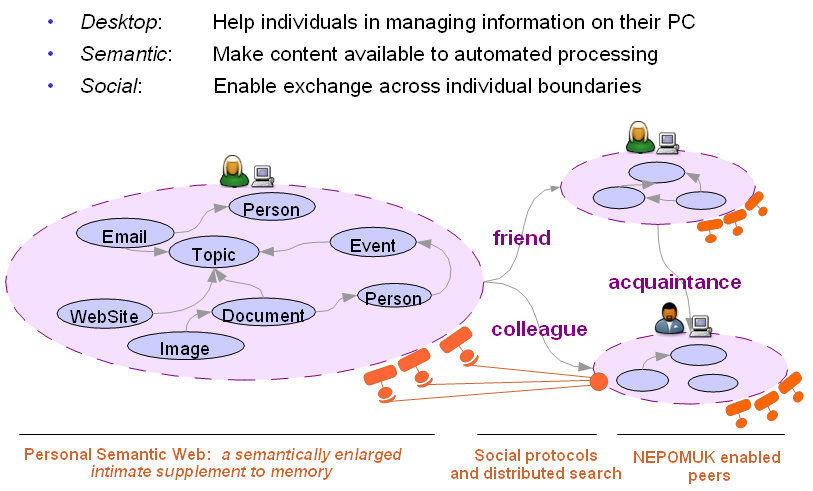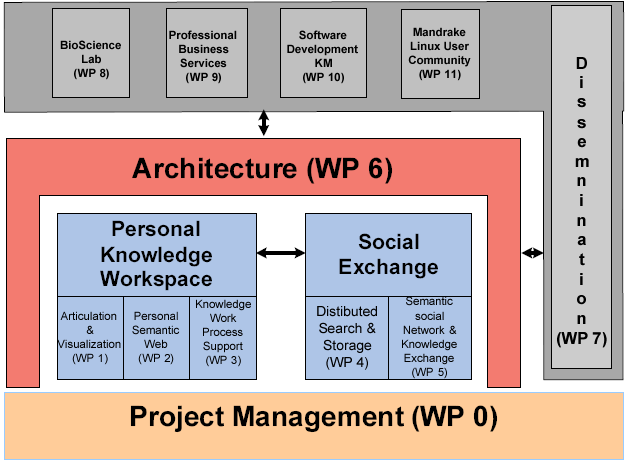January 2006–December 2008

#Project description
Human knowledge work mainly consists of the reception, interpretation and structuring of information, the explicit articulation of thoughts in suitable representations (like texts and pictures), and the sharing, exchange and discussion of such resources with other people. The way people proceed in this is heavily influenced by tools they use: The personal workspace – and the personal computer in particular – support and reflect the individual ways of information processing, thought articulation, and knowledge sharing across social and organizational networks.
##Goal
NEPOMUK intends to realize and deploy a comprehensive solution – methods, datastructures, and a set of tools – for extending the personal computer into acollaborative environment, hich improves the state ofart in online collaboration and personal data management and augments theintellect of people by providing and organizing information created by singleor group efforts.
This solution is called the Social Semantic Desktop. Thisenhanced personal workspace (the Desktop) will be Semantic since it will giveinformation a well defined meaning, making it processable by the computer. It will be Social since it will support the interaction and exchange with otherdesktops and their users.
The components of the Social Semantic Desktop are:
-
The Semantic Web, which uses URI (Uniform Research Identifier) to provide standards and technologies for the definition and exchange of ontologies and metadata represented as RDF graphs,
-
Social Software, which maps the social connections between different people into the technical infrastructure, and
-
P2P and Grid computing, which develops technology to network large communities without centralized infrastructures, for data and computation sharing.
The figure below shows the technologies which influence the development of Social Semantic Desktop.

##Objectives
Desktop Aspect: To build the SemanticDesktop, NEPOMUK’s objectives are to develop the methods, data structures and services necessary
to annotate and link arbitrary information on the local desktop, across different media types, file formats, and applications. Semantic web data structures and techniques will be applied and adapted to achieve this goal.
to articulate and visualize the user’s ideas and transform them into semantic information. We will extend easy-to-use wiki technology and integrate it with annotation mechanisms.
to integrate content creation and processing with the users’ way of structuring their work. Key approach will be the integration of agile process modeling concepts with the information generation and structuring.
Social Aspect: To cope with theinterconnection and exchange with other desktops and their users, NEPOMUK’s objectives are to develop
tools for social relation building and knowledge exchange which support knowledge sharing within social communities. These tools will provide semantically rich recommendations, which allow members of a community to not only exchange documents and other isolated information chunks, but all relevant information about their context and the participating community as well
techniques for distributed search and storage of information, based on scalable extensions of the distributed hash table technology and p-grid infrastructures, which allow efficient search over distributed information resources and provide a shared knowledge pool within a community.
Community Uptake: The idea ofthe Social Semantic Desktop will reach its full potential only if it is adoptedand applied by a large and active community of people. The build-up of thiscommunity is a central objective of the project which will be pursued rightfrom the beginning. In detail, our objectives towards sufficient community uptake are
to realize the Social Semantic Desktop as an open framework architecture with clearly defined interfaces which are published and possibly submitted for standardization; this will allow external adopters to integrate their proprietary desktop tools into the comprehensive framework and offers ways for commercial support and extension activities
to reach early dissemination of project results and to interact with the open-source developer community; this will allow for the gathering and inclusion of feedback and development contributions form interested third parties; and finally
to prove the benefits of the Social Semantic Desktop in representative application areas which will stipulate the interest of possible industrial users and service providers in uptaking the project results.

##Results
Main visible results are:
- the architecture and implemented middleware of the Social Semantic Desktop, published as open-source software and where relevant submitted to semantic web standardization processes,
- an active scientific and user community that adopts the results of NEPOMUK and continues to extend them to their needs,
- a set of reference solution in use at SAP, HP, Thales Group, PRC, or Institut Pasteur, and a body of documented experience and methodological know-how gained in their application domains.
Core development results will be publicly availableduring the project via a web-based collaboration platform. The final architecture and toolset, together with representative application examples,will be derived both online and as a ‘public showcase’ on CD-ROM.
##Structure
The work within NEPOMUK is organized in 11 workpackages.The first group of workpackages (WP 1, WP 2 and WP 3) concentrates on thepersonal perspective of knowledge work support. The second set of workpackages(WP 4 and WP 5) deals with the social perspective. Both the personal and aswell as the social perspective comprise the realization of a framework and anumber of tools for information management. These tools have to be integratedunder a comprehensive architecture. Responsible for the development andmaintenance of the overall system architecture is WP 6. WP 7 is responsible forthe dissemination of NEPOMUK. Finally workpackages 8-11 are case studiesapplying and testing the concepts, methods and tools in several application scenarios.
The figure below shows the overall NEPOMUK structure.

##Partners & Duration
The NEPOMUK consortium consists of 16 partners (companies &universities) located in 7 European countries:
- German Research Center for Artificial Intelligence – DFKI GmbH
- International Business Machines (IBM)
- SAP AG
- Hewlett-Packard Galway Ltd
- Thales SA
- PRC Group – The Management House S.A.
- EDGE-IT
- Cognium Systems
- National University of Ireland, Galway
- Ecole Politechnique Fédérale de Lausanne
- Forschungszentrum Informatik an der Universität Karlsruhe
- L3S Research Center
- Institute of Communication and Computer Systems of the National Technical University of Athens
- Kungliga Tekniska Högskolan
- Università de la Svizzera Italiana
- Irion Management Consulting GmbH
##Role of ICCS
The main role of ICCS in NEPOMUK is to facilitate and support the adoption,application and validation of the NEPOMUK system in the work context of knowledge workers in the Time Management International (TMI), one of theworld’s largest learning consultancies, as well as to develop methodologies,guidelines and lessons learned for further application of the results of thecase study to other similar environments after the end of the project.

